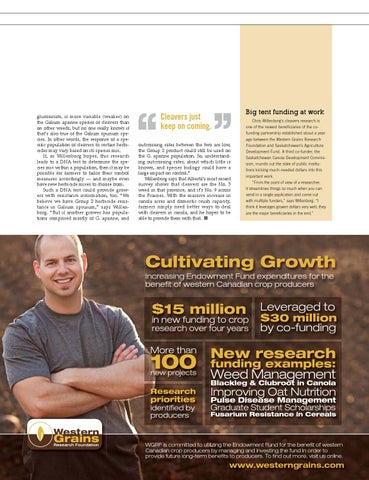glufosinate, is more variable (weaker) on the Galium aparine species of cleavers than on other weeds, but no one really knows if that’s also true of the Galium spurium species. In other words, the response of a specific population of cleavers to certain herbicides may vary based on its species mix. If, as Willenborg hopes, this research leads to a DNA test to determine the species mix within a population, then it may be possible for farmers to tailor their control measures accordingly — and maybe even have new herbicide mixes to choose from. Such a DNA test could provide growers with resistance information, too. “We believe we have Group 2 herbicide resistance in Galium spruium,” says Willenborg. “But if another grower has populations comprised mostly of G. aparine, and
Big tent funding at work
Cleavers just keep on coming. outcrossing rates between the two are low, the Group 2 product could still be used on the G. aparine population. So, understanding outcrossing rates, about which little is known, and species biology could have a large impact on control.” Willenborg says that Alberta’s most recent survey shows that cleavers are the No. 3 weed in that province, and it’s No. 9 across the Prairies. With the massive increase in canola acres and domestic crush capacity, farmers simply need better ways to deal with cleavers in canola, and he hopes to be able to provide them with that. ■
Chris Willenborg’s cleavers research is one of the newest beneficiaries of the cofunding partnership established about a year ago between the Western Grains Research Foundation and Saskatchewan’s Agriculture Development Fund. A third co-funder, the Saskatchewan Canola Development Commission, rounds out the slate of public institutions kicking much-needed dollars into this important work. “From the point of view of a researcher, it streamlines things so much when you can send in a single application and come out with multiple funders,” says Willenborg. “I think it leverages grower dollars very well; they are the major beneficiaries in the end.”
Cultivating Growth Increasing Endowment Fund expenditures for the benefit of western Canadian crop producers
$15 million
in new funding to crop research over four years
More than
100 new projects
Research
priorities identified by producers
Leveraged to $30 million by co-funding
New research funding examples:
Weed Management
Blackleg & Clubroot in Canola
Improving Oat Nutrition
Pulse Disease Management
Graduate Student Scholarships
Fusarium Resistance in Cereals
WGRF is committed to utilizing the Endowment Fund for the benefit of western Canadian crop producers by managing and investing the fund in order to provide future long-term benefits to producers. To find out more, visit us online.
www.westerngrains.com WGRF Endowment Fund Half-page Ad_final.indd 1
2013-09-12 8:34 AM
